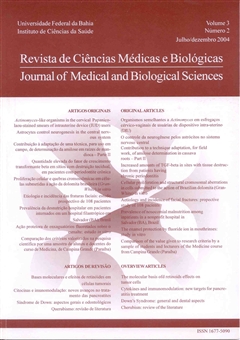Contribution to a technique adaptation, for field work, of amilose determination in cassava roots - Part II
DOI:
https://doi.org/10.9771/cmbio.v3i2.4421Keywords:
Manihot esculenta, Amylose-determination, Color scale.Abstract
This study had as objetive to standardze and adapt a method for determination of the amylose and it is based on the fundamentals of the classical colorimetry in laboratory, and later on the elaboration of scales of color that could make easier qualitative and semi-quantitative determination in the field, for selection after the crop, of cassava roots for amyloseamylopectin concentrations. The spectrometric and sensorial analyses were accomplished is six varieties os cassava from Active Bank of Germoplasm of EMBRAPA. The scale was submitted to an sensorial percent avaluation and thirty eight assessors, both for the solutions colored resultants of the development and the standard technique, with is values reduced in ten times in all of the stages of the development protocol. The statistical regression, that allowed the conclusion that proportion of successes through logical regression, that allowed the conclusion thar is possible to elaborate a protocol of adaptation of the standard technique for amylose determination in cassava roots and the use of the scale of color of the medium values of the concentration zones and it is possible to express the amylose presence qualitative and semi-quantitatively in recently-picked cassava roots.Downloads
Download data is not yet available.
Downloads
How to Cite
Rego, F. L. T., Cardoso, R. L., Matsuura, F. C. A. U., & Fernandes, G. B. (2004). Contribution to a technique adaptation, for field work, of amilose determination in cassava roots - Part II. Journal of Medical and Biological Sciences, 3(2), 168–175. https://doi.org/10.9771/cmbio.v3i2.4421
Issue
Section
ORIGINAL ARTICLES
License
The Journal of Medical and Biological Sciences reserves all copyrights of published works, including translations, allowing, however, their subsequent reproduction as transcription, with proper citation of source, through the Creative Commons license. The periodical has free and free access.


